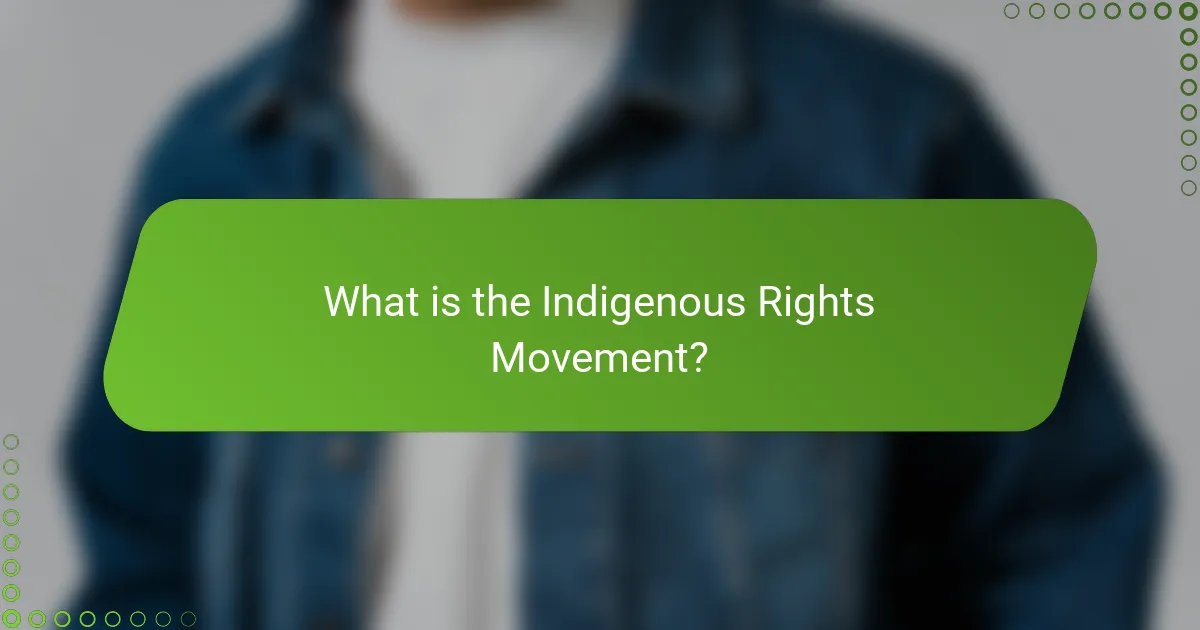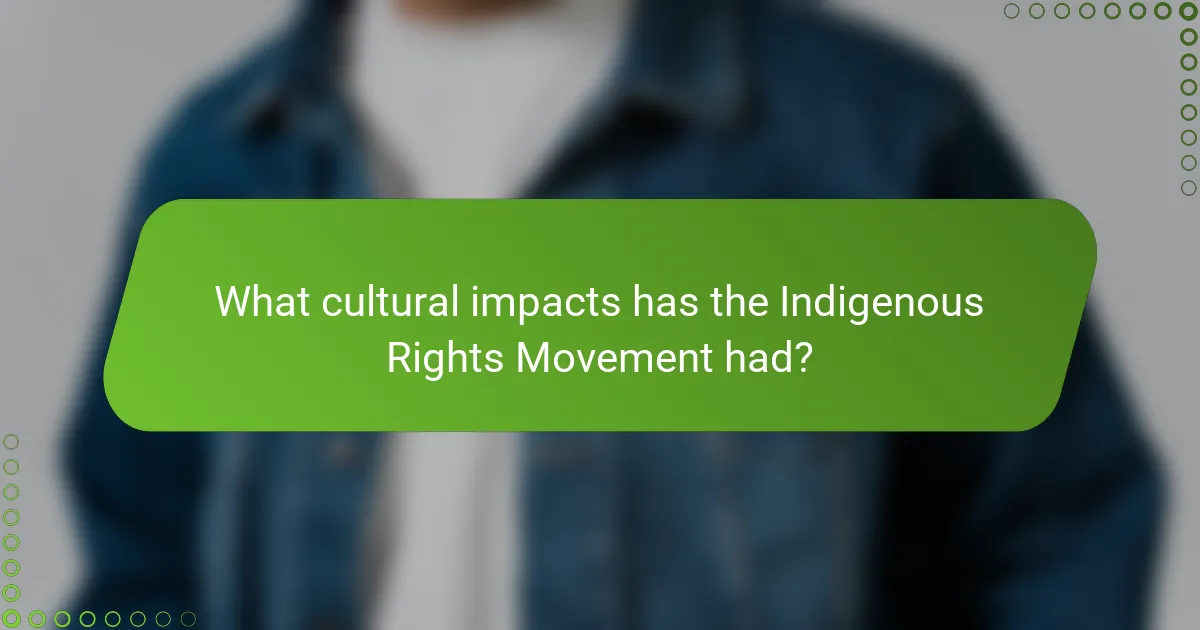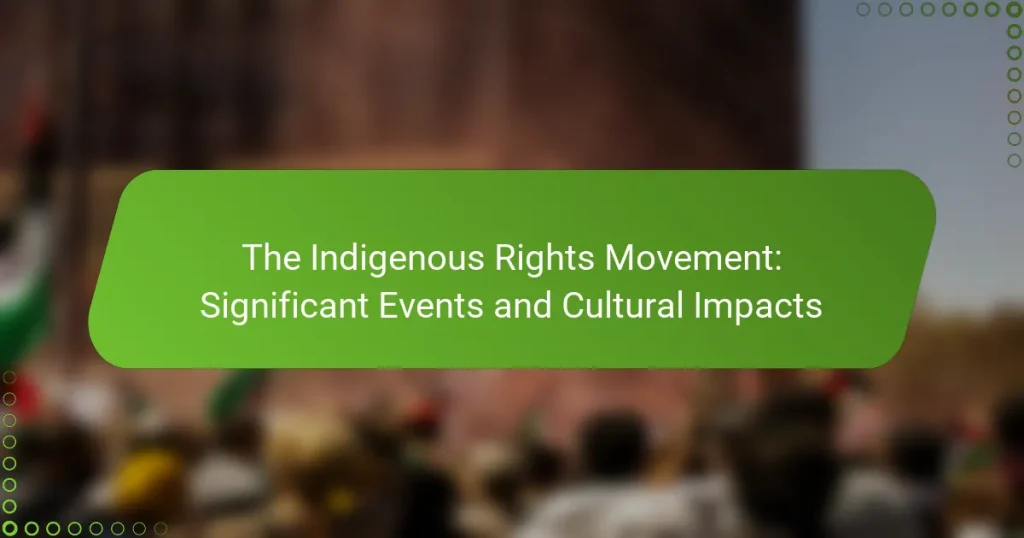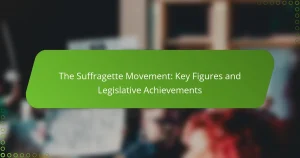The Indigenous Rights Movement is a global initiative focused on advocating for the rights and recognition of Indigenous peoples, addressing historical injustices, and promoting self-determination. Key issues within this movement include land rights, cultural preservation, and political representation, highlighted by milestones such as the adoption of the United Nations Declaration on the Rights of Indigenous Peoples in 2007. Significant historical events, such as the American Indian Movement, the occupation of Alcatraz Island, and the Wounded Knee incident, have shaped the movement and increased visibility of Indigenous issues. The movement has led to a resurgence of Indigenous languages and traditions, greater public awareness, and changes in national policies, reflecting a broader societal appreciation for Indigenous cultures.

What is the Indigenous Rights Movement?
The Indigenous Rights Movement is a global campaign advocating for the rights and recognition of Indigenous peoples. This movement seeks to address historical injustices and promote self-determination. It encompasses various issues, including land rights, cultural preservation, and political representation. Significant milestones include the United Nations Declaration on the Rights of Indigenous Peoples in 2007. This declaration emphasizes the rights of Indigenous communities worldwide. Activists work to raise awareness and influence policy changes. The movement has led to increased visibility of Indigenous issues in international forums. Overall, it aims to empower Indigenous peoples and protect their heritage.
How did the Indigenous Rights Movement begin?
The Indigenous Rights Movement began in the mid-20th century as Indigenous peoples sought recognition and protection of their rights. This movement emerged in response to historical injustices, including colonization and land dispossession. Key events, such as the formation of organizations like the National Congress of American Indians in 1944, galvanized efforts for advocacy. The movement gained momentum through protests, legal challenges, and cultural revitalization efforts. Landmark events included the occupation of Alcatraz Island in 1969 and the establishment of the United Nations Declaration on the Rights of Indigenous Peoples in 2007. These actions highlighted the need for social justice and equality for Indigenous communities globally.
What historical events sparked the Indigenous Rights Movement?
The Indigenous Rights Movement was sparked by several historical events. Key events include the 1969 publication of the “Statement of the American Indian Movement.” This document highlighted systemic injustices faced by Indigenous peoples. Another significant event was the 1973 Wounded Knee occupation. Activists protested against government policies and demanded recognition of treaty rights. The 1965 Voting Rights Act also played a role by securing voting rights for Indigenous peoples. Additionally, the 1970s saw the rise of land reclamation movements. These movements aimed to reclaim traditional lands taken by governments. Each of these events contributed to raising awareness and mobilizing support for Indigenous rights.
Who were the key figures in the early stages of the movement?
The key figures in the early stages of the Indigenous Rights Movement include leaders like Vine Deloria Jr., Wilma Mankiller, and Billy Frank Jr. Vine Deloria Jr. was a prominent author and activist who advocated for Native American rights and sovereignty. Wilma Mankiller served as the first female chief of the Cherokee Nation and focused on self-determination and community development. Billy Frank Jr. was a Nisqually tribal leader who fought for fishing rights and treaty rights in Washington State. Their contributions significantly shaped the movement’s direction and goals in the 20th century.
Why is the Indigenous Rights Movement important?
The Indigenous Rights Movement is important because it advocates for the recognition and protection of the rights of Indigenous peoples. This movement seeks to address historical injustices, including land dispossession and cultural erasure. It emphasizes the need for self-determination and sovereignty for Indigenous communities. The movement has led to significant legal advancements, such as the United Nations Declaration on the Rights of Indigenous Peoples. This declaration affirms the rights of Indigenous peoples globally. Additionally, the movement raises awareness about social and environmental issues affecting Indigenous lands. It promotes cultural preservation and revitalization of Indigenous languages and traditions. The importance of this movement is evident in its role in fostering justice and equality for Indigenous populations.
What impact has the movement had on Indigenous communities?
The Indigenous rights movement has significantly empowered Indigenous communities. It has raised awareness about their rights and cultural heritage. The movement has led to legal recognition of land rights in several countries. For example, the 1973 American Indian Movement’s occupation of Wounded Knee highlighted the need for sovereignty. This event catalyzed legislative changes, such as the Indian Self-Determination and Education Assistance Act of 1975. Additionally, the movement has fostered cultural revitalization efforts among Indigenous peoples. Initiatives in language preservation and traditional practices have gained momentum. Overall, the movement has positively influenced political representation and social justice for Indigenous communities.
How has the movement influenced national and international policies?
The Indigenous Rights Movement has significantly influenced national and international policies. It has led to the recognition of Indigenous rights in various countries. For instance, Canada adopted the United Nations Declaration on the Rights of Indigenous Peoples (UNDRIP) in 2016. This declaration emphasizes the rights of Indigenous peoples to self-determination and land. Similarly, New Zealand has enacted laws protecting Māori land and culture. Internationally, the movement has prompted organizations like the United Nations to address Indigenous issues. The International Labour Organization’s Convention 169 highlights Indigenous rights in labor policies. These changes reflect the movement’s impact on shaping legal frameworks and promoting social justice for Indigenous communities.
What are the main goals of the Indigenous Rights Movement?
The main goals of the Indigenous Rights Movement include the recognition of land rights, cultural preservation, and self-determination. The movement aims to reclaim ancestral lands taken by colonial powers. It seeks to protect and promote Indigenous languages, traditions, and customs. Additionally, it advocates for political representation and legal rights within national frameworks. The movement addresses social justice issues, including health, education, and economic disparities faced by Indigenous communities. Historical treaties and agreements are often referenced to support these claims. The movement also emphasizes environmental stewardship and the protection of sacred sites. Overall, it strives for equality and respect for Indigenous peoples globally.
What rights are being advocated for by Indigenous groups?
Indigenous groups advocate for land rights, self-determination, cultural preservation, and access to resources. They seek recognition of their sovereignty and legal rights over ancestral territories. Land rights include the right to use and manage traditional lands. Self-determination allows Indigenous peoples to govern themselves and make decisions affecting their communities. Cultural preservation focuses on maintaining languages, traditions, and practices. Access to resources includes fishing, hunting, and gathering rights. These rights are essential for the survival and well-being of Indigenous cultures. Historical treaties and international agreements, like the UN Declaration on the Rights of Indigenous Peoples, support these claims.
How do these goals vary across different Indigenous cultures?
Goals vary significantly across different Indigenous cultures due to unique historical, social, and environmental contexts. For example, some Indigenous groups prioritize land sovereignty and environmental stewardship, reflecting their deep-rooted connection to the land. Others focus on cultural preservation and language revitalization, aiming to maintain their distinct identities. In North America, tribes like the Navajo emphasize economic development alongside cultural preservation, while the Maori in New Zealand advocate for political representation and treaty rights. Each culture’s goals are shaped by specific challenges they face, such as colonization, resource extraction, and climate change. These diverse priorities highlight the rich tapestry of Indigenous experiences and aspirations globally.

What significant events have shaped the Indigenous Rights Movement?
The Indigenous Rights Movement has been shaped by several significant events. The American Indian Movement (AIM) was founded in 1968 to address issues of sovereignty and civil rights. The occupation of Alcatraz Island from 1969 to 1971 highlighted Indigenous demands for land rights. The 1973 Wounded Knee incident brought national attention to Indigenous struggles against the U.S. government. The United Nations Declaration on the Rights of Indigenous Peoples was adopted in 2007, affirming Indigenous rights globally. The 1990s saw the establishment of Indigenous Peoples’ Day, promoting recognition and respect for Indigenous cultures. These events collectively advanced the visibility and rights of Indigenous peoples.
What landmark events have defined the movement’s trajectory?
The Indigenous Rights Movement has been shaped by several landmark events. The American Indian Movement’s formation in 1968 marked a significant turning point. The occupation of Alcatraz Island from 1969 to 1971 highlighted Indigenous issues nationally. In 1978, the American Indian Religious Freedom Act was passed, recognizing the right to practice Indigenous religions. The 1990 passage of the Native American Graves Protection and Repatriation Act facilitated the return of ancestral remains. The 2007 United Nations Declaration on the Rights of Indigenous Peoples was a global affirmation of Indigenous rights. Each of these events has played a crucial role in advancing the cause of Indigenous rights and recognition.
How did the 1969 occupation of Alcatraz influence public perception?
The 1969 occupation of Alcatraz significantly shifted public perception regarding Indigenous rights. The event brought national attention to the struggles of Native Americans. Activists highlighted issues such as land rights and sovereignty. The occupation lasted for 19 months, serving as a protest against government policies. It galvanized support for Indigenous movements across the United States. Public awareness increased about the historical injustices faced by Native peoples. Media coverage played a crucial role in shaping perceptions. The event is often seen as a catalyst for the modern Indigenous rights movement.
What role did the 1973 Wounded Knee incident play in activism?
The 1973 Wounded Knee incident significantly heightened activism among Native Americans. This event involved a 71-day standoff between the American Indian Movement (AIM) and federal authorities. It brought national attention to the struggles faced by Indigenous peoples. Activists used the incident to highlight issues of treaty rights and sovereignty. The media coverage mobilized support for Indigenous rights across the United States. It also inspired future generations to engage in activism. The incident is often viewed as a pivotal moment in the Indigenous rights movement. It demonstrated the power of organized resistance against systemic oppression.
How have protests and demonstrations impacted the movement?
Protests and demonstrations have significantly advanced the Indigenous Rights Movement. They have raised awareness about injustices faced by Indigenous communities. High-profile protests, such as the Standing Rock demonstrations against the Dakota Access Pipeline, garnered international attention. This led to increased media coverage and public support for Indigenous issues. Additionally, protests have pressured governments to address treaty violations and land rights. Demonstrations have also fostered solidarity among Indigenous groups. They have empowered Indigenous youth to engage in activism. Overall, protests have played a critical role in shaping the movement’s goals and strategies.
What are some notable protests that garnered media attention?
Notable protests that garnered media attention include the Standing Rock protests against the Dakota Access Pipeline. These protests occurred from 2016 to 2017. Thousands of Indigenous activists and allies gathered to oppose the pipeline’s construction. The protests highlighted issues of environmental protection and Indigenous sovereignty. Media coverage was extensive, showcasing the conflict between protesters and law enforcement. Another significant protest was the 1990 Oka Crisis in Canada. This standoff involved the Mohawk community opposing the expansion of a golf course on sacred land. The event received widespread media attention and raised awareness of Indigenous land rights. The Indigenous rights movement has seen many such protests that brought global focus to their struggles.
How have these protests changed public opinion on Indigenous rights?
Protests have significantly shifted public opinion on Indigenous rights. Increased visibility of Indigenous issues has led to greater awareness among the general public. Many people now recognize the historical injustices faced by Indigenous communities. Polls indicate rising support for Indigenous land rights and self-determination. For instance, a 2021 survey showed that 70% of Canadians support Indigenous land claims. This change is partly due to media coverage of protests and social media activism. Public discourse has evolved, with more discussions on reconciliation and justice. Overall, protests have fostered a more empathetic understanding of Indigenous rights among the broader population.

What cultural impacts has the Indigenous Rights Movement had?
The Indigenous Rights Movement has significantly impacted cultural identity and recognition of Indigenous peoples. It has led to a resurgence of Indigenous languages and traditions. Many Indigenous communities have revitalized cultural practices that were suppressed. The movement has also fostered greater awareness of Indigenous histories and contributions. Public education campaigns have increased understanding of Indigenous rights issues. Cultural events celebrating Indigenous heritage have gained prominence. Additionally, the movement has influenced national policies regarding land rights and sovereignty. These changes reflect a broader acceptance and appreciation of Indigenous cultures in society.
How has the movement influenced Indigenous identity and culture?
The Indigenous Rights Movement has significantly influenced Indigenous identity and culture. It has fostered a resurgence of cultural pride among Indigenous communities. Activism has led to the revitalization of traditional practices and languages. Increased visibility of Indigenous issues has encouraged younger generations to embrace their heritage. Legal victories have affirmed the rights to land and cultural expression. The movement has also created platforms for Indigenous voices in politics and media. Events such as land claims and protests have united diverse Indigenous groups. This solidarity has strengthened collective identity and cultural resilience.
What role has art played in expressing Indigenous rights issues?
Art has played a crucial role in expressing Indigenous rights issues. It serves as a powerful medium for storytelling and cultural preservation. Through various forms like painting, music, and performance, Indigenous artists communicate their experiences and struggles. Art raises awareness about historical injustices faced by Indigenous communities. It fosters a sense of identity and belonging among Indigenous peoples. Notable examples include the works of artists like Emily Carr and Norval Morrisseau. Their art highlights the connection to land and culture. Additionally, art has been used in protests and movements to advocate for rights and recognition. It creates a visual narrative that captures the attention of broader audiences.
How have traditional practices been revitalized through the movement?
Traditional practices have been revitalized through the Indigenous Rights Movement by promoting cultural awareness and community engagement. The movement has encouraged the preservation of languages, rituals, and customs that were at risk of being lost. Increased visibility of Indigenous issues has led to educational programs that teach traditional knowledge. Additionally, land rights victories have allowed communities to practice their cultural traditions on ancestral lands. Events such as powwows and cultural festivals have gained popularity, further fostering a sense of identity. Collaborative efforts with non-Indigenous allies have also strengthened the movement’s impact on cultural revitalization. These actions collectively contribute to a renewed appreciation and practice of Indigenous heritage.
What are the broader societal implications of the movement?
The broader societal implications of the Indigenous Rights Movement include increased awareness of indigenous issues and recognition of their rights. This movement has led to significant legal reforms in various countries, such as the United Nations Declaration on the Rights of Indigenous Peoples adopted in 2007. Indigenous communities have gained greater visibility in political discourse, influencing policies that affect their land, culture, and resources. The movement promotes social justice and equality, challenging systemic discrimination faced by indigenous populations. Additionally, it fosters cultural revitalization, encouraging the preservation and celebration of indigenous languages and traditions. Economic opportunities have also emerged, with initiatives aimed at sustainable development that respect indigenous knowledge and practices. Overall, the movement contributes to a more inclusive society that acknowledges the historical injustices experienced by indigenous peoples.
How has the movement affected non-Indigenous perceptions of Indigenous cultures?
The Indigenous Rights Movement has significantly shifted non-Indigenous perceptions of Indigenous cultures. Increased visibility of Indigenous issues has led to greater awareness and understanding. Educational initiatives have highlighted the historical injustices faced by Indigenous peoples. This has fostered empathy and respect among non-Indigenous communities. Cultural exchanges have allowed for deeper appreciation of Indigenous traditions and values. Media representation has also played a crucial role in changing stereotypes. Reports indicate that younger generations show more positive attitudes towards Indigenous cultures. This transformation reflects a broader societal shift towards inclusivity and recognition of Indigenous rights.
What lessons can be learned from the Indigenous Rights Movement for other social justice movements?
The Indigenous Rights Movement teaches the importance of grassroots organizing and coalition-building. Effective social justice movements often rely on local communities to drive change. The movement demonstrates the power of storytelling in raising awareness and fostering empathy. Personal narratives can humanize issues and mobilize support. Additionally, it highlights the significance of legal frameworks in protecting rights. Successful advocacy often involves navigating legal systems to achieve tangible outcomes. The movement also shows the need for intersectionality. Recognizing how different identities intersect can strengthen solidarity among various groups. Lastly, the importance of cultural preservation is evident. Upholding cultural identity can empower communities and enhance resilience against oppression.
What practical steps can individuals take to support Indigenous rights?
Individuals can support Indigenous rights by educating themselves about Indigenous histories and cultures. Understanding the challenges faced by Indigenous communities is crucial. Engaging with Indigenous voices through literature, art, and media fosters awareness. Supporting Indigenous businesses and artisans helps promote economic independence. Advocating for policy changes that protect Indigenous land and rights is essential. Participating in local events and initiatives that uplift Indigenous communities strengthens solidarity. Donating to Indigenous-led organizations aids in their efforts for justice and equality. Lastly, practicing allyship by listening and amplifying Indigenous perspectives is vital for meaningful support.
The Indigenous Rights Movement is a global campaign focused on advocating for the rights and recognition of Indigenous peoples, addressing historical injustices related to land rights, cultural preservation, and political representation. This article explores the movement’s origins, significant events that shaped its trajectory, and key figures who contributed to its development. It also examines the cultural impacts of the movement, including the revitalization of Indigenous languages and traditions, as well as the broader societal implications regarding awareness and recognition of Indigenous rights. Additionally, practical steps for individuals to support Indigenous rights are outlined, emphasizing the importance of education, advocacy, and allyship.




